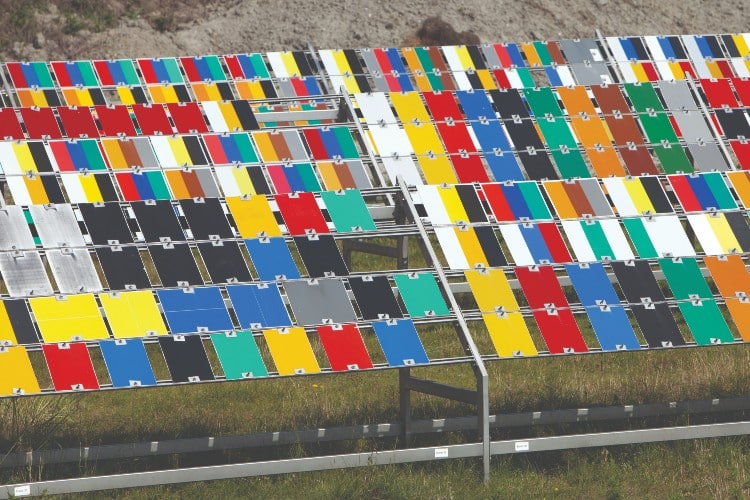Full title: Cooperative Development of an ASTM Accelerated Dirt Pickup Resistance Method with Correlation to Natural Outdoor Weathering
By Keith Alderfer, James Maher, Partha Majumdar, and Jeff Sweeney, The Dow Chemical Company
The Architectural Subcommittee of ASTM’s Paint and Related Coatings, Materials and Applications Committee (D01.42), in collaboration with industrial partners, investigated an accelerated laboratory method to assess the exterior dirt pickup resistance of architectural coatings.
A concurrent exterior exposure study was conducted with seven commercial paints across seven locations with varied climates throughout the United States for 36 months. The accelerated laboratory method explored multiple variables including dry time of the coating and QUV exposure time.
For the exterior study, to understand the impact of multiple variables and their interactions on final response, a robust statistical methodology was applied utilizing both a mixed model with fixed and random effects to account for repeated measure analysis and a standard least square linear regression. Finally, the results from the two methods, laboratory and exterior, were compared to understand the similarity of the overall trends.
INTRODUCTION
ASTM Subcommittee D01.42 is responsible for paint and coatings test methods, and dirt pickup resistance (DPUR) is an important performance attribute for exterior coatings. As the global emphasis on sustainability increases in the coatings industry, the reduction of volatile organic compounds (VOCs) for low-VOC latex paints is an industry imperative.
The coatings industry often employs nonvolatile coalescing agents and low-Tg polymers with a reduced need for coalescents, resulting in coatings that are especially prone to unsightly dirt collection. DPUR assessment by natural weathering is costly and time consuming.1,2 Since DPUR is also a function of climate and air quality, careful coordination of exposure data collection across multiple geographical locations is key to the data quality and subsequent analysis and interpretation.
The ASTM Subcommittee D01.42 is committed to developing a standard method for accelerated DPUR with strong correlation to natural exposure. Early in the development of the accelerated method it was deemed critical to generate natural weathering dirt pickup data for comparative purposes.
Exterior exposures began in June 2015 and were completed by April 2019. Each study accumulated three years’ worth of data. The exposures and data collection were carefully implemented across multiple geographical locations to ensure high data quality for analysis and interpretation. A preliminary laboratory study confirms the correlation of the proposed accelerated DPUR method with natural exterior exposure.
The completion of this work relied on the broad involvement from several paint companies and raw material suppliers in the program, summarized in the acknowledgments at the end of this article. Along with individual contributions, a wealth of corporate resources has been committed to enable this collaborative study. Participating companies included Arkema, ASTM Interlaboratory Study Program, Atlas, Azelis Americas, Boeing, The Dow Chemical Company, Eastman Chemical Company, Marschall Laboratories, PPG Industries, Sherwin Williams Company, and Wacker.
